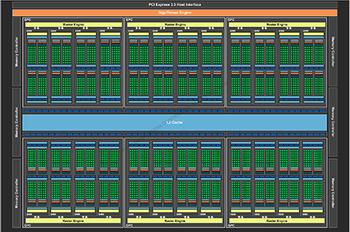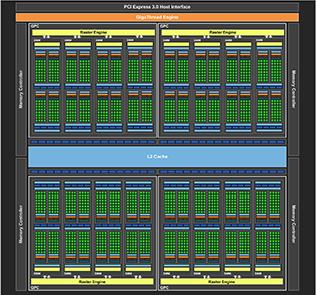Introduction
The Nvidia GeForce GTX 980 graphics processor has held the title of world's fastest GPU since its launch in September 2014. Equipped with a second-generation Maxwell architecture, the 2,048-shader part is able to mete out acceptable framerates when tasked with rendering modern games at a lofty 4K (3,840x2,160) resolution.
Perhaps more impressive is the energy efficiency aspect of the GPU, consuming up to 165W over extended periods, which enables add-in board partners to produce quiet cards that certainly don't skimp on performance.
Yet this second-generation Maxwell GPU - a full implementation of the GM204 die - is the warm-up act before the main gig. You see, the ultra-enthusiast Maxwell GPU, home to a gazillion transistors and silly amounts of VRAM, has yet to reveal itself... until now.
This new Nvidia beastie is called the GeForce GTX Titan X. Schizophrenic in nature - part professional card and part games-playing behemoth - Nvidia is releasing Titan X before rival AMD can get its new Radeon 300-series GPUs out in the wild.
Titan X is Maxwell technology in its fullest, chest-beating form. Most of you don't need one, a scant few can afford the $999 price point, and, of course, there's considerable value to be had elsewhere. Titan X is about pushing that GPU envelope out that little bit farther, so keeping up with tradition by rolling out the Table of Doom™, let's see what all the supposed fuss is about.
Nvidia GeForce GTX Titan X (12GB) |
Nvidia GeForce GTX 980 (4GB) |
Nvidia GeForce GTX 780 Ti (3GB) |
Nvidia GeForce GTX Titan (6GB) |
AMD Radeon R9 290X (4GB) |
AMD Radeon R9 290 (4GB) |
|
| Launch date | March 2015 |
September 2014 |
May 2013 |
Feb 2013 |
October 2013 |
November 2013 |
| Codename | GM200 |
GM204 |
GK110 |
GK110 |
Tahiti |
Tahiti |
| Process (nm) | 28 |
28 |
28 |
28 |
28 |
28 |
| Transistors (mn) | 8,000 |
5,200 |
7,080 |
7,080 |
6,200 |
6,200 |
| Approx Die Size (mm²) | 601 |
398 |
551 |
551 |
438 |
438 |
| Full implementation of die | Yes |
Yes |
Yes |
No |
Yes |
No |
| SM Units | 24 |
16 |
15 |
14 |
NA |
NA |
| Processors | 3,072 |
2,048 |
2,880 |
2,688 |
2,816 |
2,560 |
| Texture Units | 192 |
128 |
240 |
224 |
176 |
160 |
| ROP Units | 96 |
64 |
48 |
48 |
64 |
64 |
| Peak GPU Clock/Boost (MHz) | 1,076 |
1,216 |
928 |
876 |
1,000 |
947 |
| Peak GFLOPS (SP) | 6,611 |
4,981 |
5,345 |
4,709 |
5,632 |
4,849 |
| Peak GFLOPS (DP) | 207 |
156 |
223 |
1,570 |
704 |
606 |
| Memory Clock (MHz) | 7,012 |
7,012 |
7,012 |
6,008 |
5,000 |
5,000 |
| Memory Bus (bits) | 384 |
256 |
384 |
384 |
512 |
512 |
| Max bandwidth (GB/s) | 336 |
224 |
336 |
288 |
320 |
320 |
| Default memory size (MB) | 12,288 |
4,096 |
3,072 |
6,144 |
4,096 |
4,096 |
| Power Connectors | 8+6-pin |
6+6-pin |
8+6-pin |
8+6-pin |
8+6-pin |
8+6-pin |
| TDP (watts) | 250 |
165 |
250 |
250 |
250 |
250 |
| GFLOPS per watt | 26.44 |
30.19 |
21.38 |
18.83 |
22.52 |
19.40 |
| Current price (Newegg) | $999 |
$549 |
NA |
NA |
$399 |
$299 |
Lots of big numbers
It is the very energy-efficient nature of the Maxwell architecture that enables Nvidia to build a bigger, faster die without compromising thermal limits dictated by air cooling. So just how fast and wide is the new GPU?
It's a physical throwback to the GK110 die featured on the GeForce GTX 780 (Ti) and Titan cards based on the Kepler architecture. Commonality extends to having 3,000-odd shaders, a wider memory bus and a 250W TDP. Titan X is the logical successor to those GPUs, not the smaller, leaner GTX 980.
Nvidia's design tactic has been to balloon the GTX 980 die out in all areas once yields of the Maxwell process, still built on 28nm, have matured sufficiently. This ballooning is represented by a 50 per cent increase in the building blocks of the top-end, represented by two more GPC clusters, thus leading to 3,072 cores and 192 texture units.
GM200 (left) vs. GM204 (right) - 50 per cent bigger in most respects
Nvidia keeps this 50 per cent mantra intact by increasing the number of ROPs by half again. More throughput requires a thicker, faster interface to memory bandwidth. Rather than incur extra risk by introducing newer technologies, as AMD is doing with the R9 390-series, the memory interface is a standard 384 bits (6x64-bit pathways) that talks to RAM rated at 7Gbps. In this respect it is identical to the GTX 780 Ti, though fundamentally more efficient due to the colour-compression technology present in the latest Maxwell chips.
Titan cards are often described as the professional Quadro cards on the cheap due to their improved double-precision capabilities. For example, the regular Titan can process DP calculations at 1/4 SP speed while the GTX 780 Ti - an otherwise similar card - runs DP at 1/24. GTX 980 drops this ratio to 1/32 and, surprisingly, Nvidia deliberately hampers Titan X by keeping the same DP-to-SP ratio. In short, the Titan X's double-precision ability is far, far lower than the Kepler-based Titan's.
You want a Quadro card for scientific computing, you pay for it, appears to be Nvidia's thinking, so the launch of the Quadro M6000, based on the same GM200 die but with faster DP support, is another entirely predictable move.
RAMming it home
A logical by-product of a wider bus is a difference in onboard memory. Though a 384-bit bus can still use a 4GB framebuffer by having different density chips, previous cards have used either 3GB (GeForce GTX 780/Ti) or 6GB (Titan). Yet Nvidia goes overboard by equipping Titan X with 12GB of GDDR5 memory. The green team's argument is that it wants the ultimate, no-compromise gaming card and while 6GB is enough for today and tomorrow, 12GB ensures that memory footprint isn't the limiting factor.
Doubling the supposed amount of memory increases the cost of the card, unnecessarily so in our opinion, but Nvidia has probably chosen to do this to leave room for a GeForce GTX 980 Ti... one using this base GM200 architecture in some form and kitted out with more sensible 6GB of GDDR5 RAM.
Titan X is a pre-emptive strike against the next generation of Radeon cards. Should they turn out to be faster than expected Nvidia can turn up the frequency wick on both counts and release said GTX 980 Ti 6GB at a rival price-point. Should R9 390X be slower, and so much is unknown right now, Nvidia can massage the frequencies accordingly.
The $999 GeForce GTX Titan X 12GB is a 50 per cent bigger version of the GTX 980. Educated guesses would say that clock for clock it'll be around 40-50 per cent faster at high resolutions, making it ideal as the no-holds-barred single-GPU card for 4K gaming.




